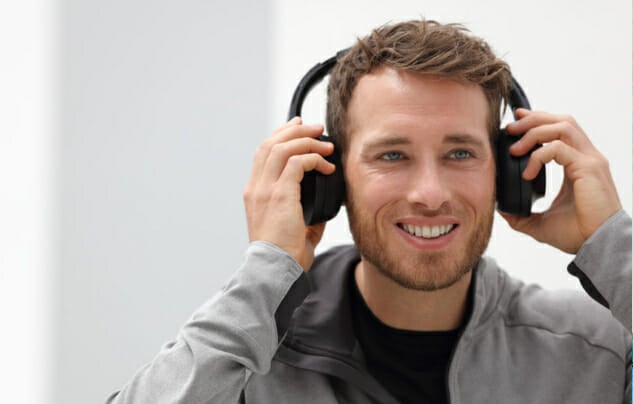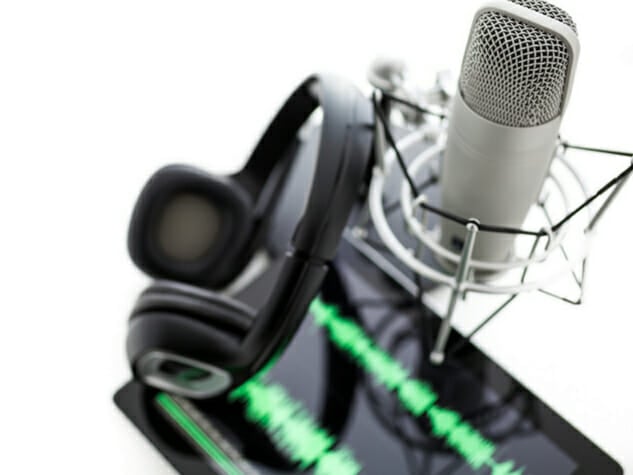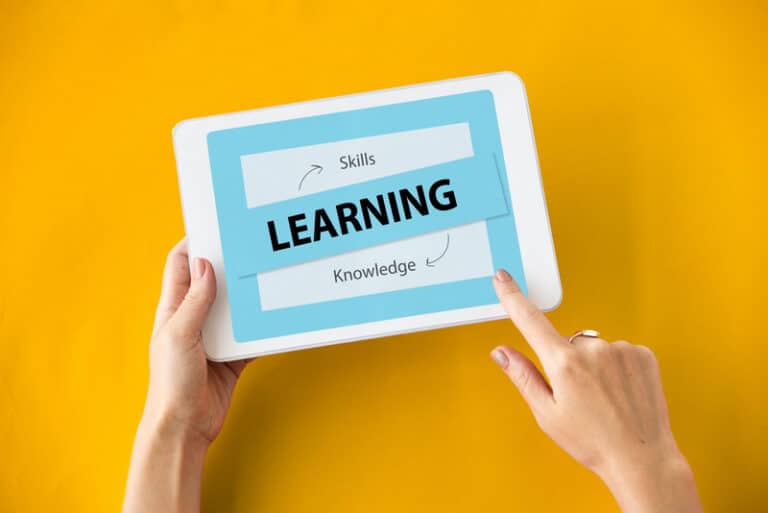Thinking about creating a podcast? Read our answers to Podcasts: FAQs. In this article, we cover the basics of podcast production. Included are: average podcast file sizes compared to video file sizes, common podcast recording formats, and podcast audience statistics.
Podcasts FAQs: Podcast Development and Statistics
Podcast file formats, delivery requirements and costs
This article is a continuation of the 4-part blog series on key differences between webinars and podcasts vs e-learning.
Definition of a Podcast: A podcast is an audio-based, digital method of communication. Most podcasts are simple voice recordings, occasionally interspersed with sound effects and background music. Podcasts are primarily used for interviews and storytelling and revolve around a particular presenter, topic or theme.
Key features of a podcast:
- a one-to-many (or two-to-many) form of communication that is not reliant on traditional media (radio or television)
- delivered as a digital series via the internet
- usually in episodic formats that revolve around a particular topic or theme
If the podcast host (presenter) is a good storyteller, a podcast can be a powerful means of communication. Podcasts provide an opportunity to reach thousands of individuals, at a relatively low cost compared to other media formats.
What software and file formats are used for creating podcasts?
- a majority of podcasts use an MP3 format (audio file type)
- alternatives include WAV, FLAC or AIFF formats
Most devices today have pre-installed voice recording software/apps.
- Numerous built-in programs provide recording options
- Simply ensure you have the proper hardware (e.g. sound card, processor capacity etc)
- Alternatively, you can purchase special audio recording/editing software and high quality recording microphones
- Just watch for background noises including HVAC systems and background conversations!
- For more on the best apps for recording podcasts, here’s an article you’ll find of interest
Podcasts: FAQs – top questions answered
FAQ#1: What is the average file size in megabytes for a podcast episode?
Podcast file sizes can vary significantly. This depends on numerous factors including the file format (MP3 vs WAV, for example), but are also impacted by:
-
- content (music vs no music, stereo or mono)
- bit rate/sampling rate (kbs)
- compression
- related server settings
Podcast file sizes (Average) 30 minutes vs 60 minutes vs video file sizes
Comparison of average MP3 podcast files sizes to MP4 video file sizes (podcasts):
- the average file sizes of videos and podcasts vary significantly even for the same recording length
- this relates to various recording factors that include bit rates, sampling, frames per second and more
- A 30-minute MP3 podcast recording ranges from 25mb to 30mb on average
- podcast file sizes are far smaller compared to video file sizes
- example 1: 30 MB file size for a 30-minute podcast episode versus 7-8 gigabytes file size for MP4 video of similar length
- example 2: 55 MB file size for a 60-minute podcast compared to 15 gigabytes for a compressed video (or up to 50 gigabytes or larger, before compression)
Even though podcasts are smaller in file size than a video of the same duration, it isn’t wise to post your podcasts on your dedicated (or shared) website server.
Good advice is NOT to host your podcast media on the same server as your website.Why? Because downloads of large media files will cause most websites to slow down to a crawl… This impacts user experiences, traffic and rankings on Google (page load speed is paramount). On shared platforms, it can slow down every other website on the server/system.
Most people use a commercial platform to host their podcasts, e.g., through an external server provider contract. Large companies may have their own dedicated servers for various functions, separating out their website server with the media servers (similar to how online GMP courses are hosted).
FAQ#2: Are podcasts a good investment?
Podcasts can become highly valuable digital assets. But the success of a podcast is dependent on 3 interactive dynamics.
- They must be properly designed.
- They must be effectively promoted.
- There must be widespread interest in the topic or theme.
Distribution and marketing strategies are crucial to ensure the success of a podcast series, covered further below.

A podcast can serve as an excellent communication medium for educating or entertaining listeners.
Many thought-leaders use podcasts as a tool to:
- build an audience base
- influence others’ opinions
- convince or inspire others to take action
- provide an audio-based alternative to text-based formats (e.g., for individuals with literacy challenges)
Businesses also use podcasts as an effective tool to:
- generate sales leads (e.g., a writer might make a podcast as a way to sell more books)
- increase brand awareness
- improve the value of their reputation or brand
And podcasts are also suitable for advocates or activists because they can increase public awareness, and understanding, of hotly debated issues.
FAQ#3: What makes podcasts unique compared to other storytelling methods?
- Ease of access
- File size: Podcasts are uni-media vs multi-media — they do not include videos or graphics
- Lower hosting costs than multi-media
- The convenience of using an audio-only format vs a video format
- Can be listened to on most modern devices using headsets and headphones
- Can be listened to without interrupting others nearby
Having a relatively smaller file size — compared to webinar content and videos — also enables most podcasts to be:
- rapidly uploaded, downloaded or streamed via the internet
- readily accessed without exceeding current data-usage plans
- easily stored, without requiring continual expansion of digital storage capacity
But internet speed and data capacity still have an impact on how easily you can upload, and download, a podcast series.
Podcasts may, however, be promoted using a visual cover image and/or promotional media.
- Podcast presenters often use videos as promotional tools to increase their podcast audience numbers
- Hence, podcast popularity may still depend on multi-media videos and social media channels for:
- visibility
- traffic gains
Podcast themes and topics: Podcast topics are wide-ranging on whole. Yet most podcast series will focus on a certain category of information. Parenting, politics, unsolved crimes and/or adventure stories are prime examples.
Most podcasts are created using several pre-recorded, scripted sessions.
- This can resemble chapters in a book, although some segments are designed to stand alone.
- Some podcasts, however, are performed live on air.
- These ‘live’ podcasts are then uploaded afterwards depending on the promotional plan.

Podcast Statistics
The average number of Podcast presenters
- Podcasts tend to feature one to two regular presenters (Average? Under 2!)
- Some podcasts integrate interviews with topic experts related to their focus area, in order to add diversity to the delivery style
Will podcast audiences grow or decline in 2020?
Podcasts have been growing in popularity over recent years. This trend is expected to continue from 2020-2025.
This is largely due to:
- accessibility (listen discreetly, on nearly any device, with minimal data usage and minimal interruption to people nearby)
- low-cost memberships (with podcast subscriptions ranging from free podcast access to under $50 USD a year for a number of popular podcast subscriptions)
Number of global podcasts: 2020 Statistics (2019-2020)
- There are an estimated 850,000 or more different podcast series (audio-only shows delivered online in the form of a podcast)
- It is believed there are over 30 million podcast episodes
- They range widely in length but most fall into the 30-minute to 60-minute timeframe, with a 37-minute average time length.
The typical length of a podcast is just under 40 minutes (average). But the recommendation is to keep your podcast ‘commute-size’ in length (under 20 to 30 minutes max). Scripting is often required to avoid going off on tangents.
Podcast listeners demographics and statistics
- According to a release on podcast statistics published by SmallBizGenius: “Brands that advertise their products and services on business podcasts enjoy an average 14% rise in purchase intent.”
- Research also indicates that up to 4 or 5 in 10 people that listen to podcasts have an annual income of > $250,000 USD
The problem with podcasts in relation to a lack of graphics (uni-media vs multi-media).
- Podcasts lack graphics information (visual stimuli) for conveying concepts and messages
- So podcasts will NOT suit conveying complex figures, trends and other statistics, where graphic illustrations would enrich potential comprehension
- However, because words are such a powerful communication method for conveying messages and influencing opinions, podcasts are well-suited to a variety of topics
Globally, On average, one (1) to two (2) presenters are typically featured in a single podcast or podcast series.
Most podcasts feature one key presenter (or two presenters) that use either a story-telling or educational approach and/or interview-style format.
- Storytelling: podcasts are particularly suited for storytelling
- It helps to use presenter(s) with appealing voices and vocal control
- Engaging speaking skills are paramount

On average, how many podcast episodes are in an individual podcast series?
Podcasts are typically presented as a series of two or more recorded sessions, often recorded and posted on a weekly or fortnightly basis.
- Some podcasts focus on a designated topic using a specific narrator
- Others mix up presenters and/or themes
- Whichever podcast format is selected, the duration of the podcast (time length of the audio sessions), total number of podcasts in a series, is highly variable across presenters.
- Often the number of podcasts in an average series will depend upon (a) the breadth and depth of the topic/content or story length, (b) audience interest levels, (c) advertising income from distributing the podcast, and (d) other incentives for producing a podcast.
Podcast Requirements
How do you create a podcast?
Requirements to produce and distribute a podcast include:
- conceptualising your topic of interest
- outlining your delivery through scriptwriting and/or scene storyboarding
- choosing your presenters/podcast host(s) and/or interviewees
- producing your podcast using a good microphone, quiet location and audio editing programs
- posting your podcast on a server (hosting fees apply)
- describing and tagging your podcast when uploading to a dedicated podcast server, so that it will be findable in searches (podcast SEO/search engine optimisation)
- promoting your podcast
Technology for Podcasts
- Podcasts can often be created with your existing devices but are best created using:
- a high-end microphone
- a quiet environment for recording (studio environment or very quiet office space)
- They require less technological expertise and fewer costs to produce, on average, than webinars or e-learning courses
- Podcasts also use far less data (megabytes vs gigabytes) than webinars and videos
You should post your podcasts to a dedicated podcast server (this should NOT be your own website, or it could slow it down to a crawl and impede your traffic and google ranking)
Audience requirements to listen to a podcast:
For your audience, podcasts are typically accessible to via numerous modern devices so long as they have sound cards/audio capacity or, for hearing impaired (as an example), text on screen.
This means most podcasts can be listened to on a variety of devices, such as a:
- smartphone
- tablet
- computer/laptop
- other device including home audio systems
Podcasts are often downloadable as MP3 files. They can then be played on home or vehicle audio systems,
However, if you protect your podcast IP, you may choose to block download capacity. In this scenario, you’d require all listeners to be logged in and using the digital streaming method for podcast access.
Podcast topics
Podcast content may include:
- Story-telling
- Excerpts from publications
- A dramatisation of real-life scenarios
- Comedic content
- Interviews with industry experts
- OR all four of the above, at once.
Podcast Distribution Strategies
Benefits of Podcasts
The benefit of a podcast is that it can be easily shared or accessed wherever there is internet download capacity and/or digital streaming. This means a podcast can spread globally even to individuals with low-data usage plans or slow internets, compared to high-data use webinars or e-learning.
- A podcast may attract a wide-ranging geographic audience with specific topic interests
- But you must promote it
How to gain listeners for your podcast
How are podcasts promoted? Few, if any, podcasts will gain an audience without notifying the audience that it exists, and enticing them to subscribe and listen.
Advising a new podcast to a target audience tends to happen through:
- paying for advertising on social media channels and relevant websites
- sending e-newsletters to a database (e.g. to your clients and/or fans/subscribers)
- promoting the podcast across multiple digital platforms
- sharing social media posts about your podcast, including brief snippets and/or advertisements
- messaging amplification by your ‘fans/subscribers’ (one-to-many sharing) who enjoy your podcast
- guest appearances on radio shows or other media outlets
- covering a contentious topic or voicing unpopular opinions (this has drawbacks and may have legal consequences)
How much does it cost to create a podcast?
- Producing a podcast ranges from nearly-free (e.g., when using existing equipment and hosting servers) to a few hundred dollars a year per podcast series.
- If you add famous presenters, sound effects and interviewee-stipends, the cost of making a podcast will vary
- Primarily, once podcast-making equipment is purchased, then the only ongoing podcast fees are:
- hosting fees to keep the podcast available online
- promotional fees/advertising and public relations
- Advertising fees will also vary depending on:
- desired reach
- your budget
- public appeal of your podcast topic — the ‘buzz’ it generates organically (without paying for advertising)
Flexibility differences between webinars and podcasts
- Podcasts are more flexible and user-friendly than Webinar(s) or e-Learning session(s).
- Webinars and online courses tend to require more advanced computing skills than a podcast.
E-learning courses and webinars require devices that have screens as well as mouse-directed screen controls (keyboard functions) and sound cards.
- Podcasts, on the other hand, require only a device that has audio listening capacity (e.g., a sound card in your smartphone, tablet, PC or other devices)
- Access to either:
- streamed podcasts or
- downloaded audio file(s)
Podcasts may appeal most to people who travel. They also suit people who like to listen to informative topics while doing manual, repetivitive tasks. Examples include: light gardening, weeding or cleaning.
Most podcasts are free to access and cost very little to produce.

Webinar vs a Podcast (Comparison)
Comparisons are detailed further in the blog: Key differences between webinars and podcasts vs e-learning.
As a brief introduction to the key differences between developing and distributing a webinar vs a podcast, these relate to:
- Development costs
- Hosting fees
- Program/software fees
- Time frames from conceptualization to delivery
- Resources including equipment
Audio “podcast” files are typically easier to create, edit, post and host than webinars and online courses. The challenge is finding an audience who wants to listen to your material, even when you offer it for free.
Successfully promoting an appealing podcast series requires a solid distribution strategy. This includes digital marketing expertise and appropriate titling, descriptions writing and tagging when you upload your podcast.
Making a podcast is easy. Gaining an audience for your podcast is the difficult part.
Crowded digital platforms mean it is difficult to gain listeners for your digital materials, whatever they are.
Even when you use the distribution strategies we listed above.
It’s difficult to gain an audience to listen to your podcast. That’s because the digital world is increasingly crowded. Thousands of new podcasts are being uploaded on a daily basis, especially as authors, businesses and advertisers recognise the value in promoting their offerings through audio-storytelling formats.
Summary:
You need good content, excellent delivery skills and voice control…and a topic that intrigues. But that alone is not enough to create a successful podcast. You also need marketing expertise and/or advertising dollars to get your podcast heard.
It can also take months — even years — for a podcast to increase in popularity to the degree the presenters would like. That might not even happen, despite your storytelling abilities and topic choices. Paid advertising will nearly ALWAYS be required. And your digital status — from your profile biographies to your website and marketing materials — must look relevant and trendy.
Read the original article comparing key differences between webinars vs podcasts vs e-learning courses (updated February 4, 2020.
Podcast FAQs
FAQ #1: Podcast Delivery Formats
- Audio media, usually recorded and then edited using software programs (such as Audacity)
- Uploaded onto the dedicated podcast server using proper naming/tagging conventions
- high end, large-capacity
- fast and properly formatted computer system that can handle the traffic and media file volumes)
- Posted online using an open access format or a ‘locked-down’ subscription format (paid)
- Podcast listeners are typically required to sign up to the producer’s mailing list OR
- Pay for a subscription membership (annually or monthly, or per episode or podcast series)
FAQ #2: Podcast Quality: What impacts the quality of the podcast in terms of sound?
Podcast quality depends on:
- Quality of the microphone
- Suitability of the recording environment and equipment
- Appropriate distance from the microphone
- Consistent sound
- Sound equalization
- Post-editing (removing mistakes or ‘ums’ and ‘ahs’)
- Podcast listeners may be required to sign up to a mailing list or pay for a subscription membership.
FAQ #3: What do most people charge for a podcast series?
Podcast costs
- Average podcast hosting fees vary depending on the size of the audio file and the hosting plan
- For a list of popular podcast service providers (hosting servers), click here
- Podcasts tend to cost less than video hosting platforms due to smaller file sizes/bandwidth requirements
TIP: If you’re looking into outsourcing hosting on a server, find out how long the audio will remain in place over subsequent years.
FAQ #4: What is the most popular hosting platform for a podcast?
Podcast platforms can include
- Many podcasts are hosted by news stations or digital news platforms, e.g. the ABC’s podcasts
- Others are hosted by companies with a keen interest in reaching a specific target audience – potential clients and buyers
FAQ #5: Are podcasts recorded live or are they all pre-recorded?
- Most podcasts are recorded in a studio setting but some are recorded live
- Live versions may include call-ins from listeners, after which the final episode is edited and then uploaded
- Polishing or editing of podcasts or videos is known in the industry as ‘to top and tail’
FAQ #5: What is the average length of a podcast series?
- Podcasts are typically individual sessions produced as a series.
- Each segment can range from a brief version (10 minutes or less) to the average of a 20 to 30 minute podcast segments
- Some are longer and range 60 minutes to 90 minutes per segment
- The total number of podcasts in a particular series may be as few as 2 segments; or as many as 60 to 100 segments
FAQ #6: How much does making a podcast cost?
- The cost of producing and hosting a podcast series is typically minimal as stated above
- It depends on how long you want the podcast to remain online AND how much equipment you need to get started
FAQ#7: How long does a podcast remain online?
How long is a podcast available to the public?
The life-span or digital longevity of a podcast series is based upon:
- the hosting organisation’s policies
- server capacity and/or
- podcast popularity statistics
Hosting of a podcast is dependent on policies or agreements, such as contracts you make with the hosting platform provider.
It also depends on who is paying the server costs. Media outlets like the ABC may have specific protocols for how long they will leave a particular podcast series available online. E.g., if you’ve been interviewed for a podcast, ask how long the presenter/agency expects that podcast to remain ‘live’ and ‘accessible.’ It may help to keep a copy for yourself as a lot of digital media gets pushed off large websites to accommodate new programs.
- There are typically hosting-duration limits that can impact the online-longevity of your podcast series
- Certain podcasts will be removed from a hosting server at a set point in time
- This can range from a few days to a few weeks to a few years — or indefinitely if you continue to pay their hosting fees
Podcast FAQs: How do podcasts become popular?
How are podcasts promoted and/or discovered by audiences?
- Through popular podcast directories and/or
- Through podcast promotions by media agencies, social media pages and/or mainstream news stories
- Examples: https://www.buzzsprout.com/learn/podcast-directory
How are podcasts promoted?
How can you ensure your target audience will listen to your podcast?
- Through paid advertising
- Via promotions from brands or podcast sponsors
This blog is fourth of 4 articles in a series comparing podcasts to webinars vs e-learning modules. By Connie May MHST.
Read Part 1 – FAQs about differences between Webinars vs e-Learning modules vs Podcasts.
Note: In 2019, companies spent over $700 million USD on podcast development. Read more in the Forbes article on successful podcasts.
(c) All Rights Reserved.
Photo credit(s): 123rf.
Last updated on July 6th, 2023 at 10:24 am






